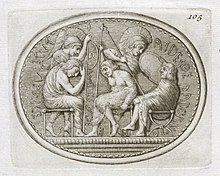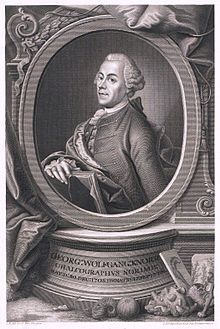Johann Adam Schweickart

Johann Adam Schweickart , also Schweikard (born October 19, 1722 in Nuremberg , † October 14, 1787 ibid), was a German draftsman and engraver in Nuremberg.
Life

He was the son of the printer Wolfgang Schweikart, and his godfather was the then famous copper engraver Johann Adam Delsenbach . On June 1, 1735, he started his five-year apprenticeship with the engraver Georg Daniel Heumann (1691–1759). Then Schweickart was a student of Georg Martin Preissler (1700–1754), later director of the Nuremberg Art Academy and son of his predecessor Johann Daniel Preissler . In 1742 he went to Florence , where the well-known art collector Baron Philipp von Stosch (1691–1757) took him into his house and Schweickart joined Stosch's service as Preissler's successor; Preissler was now the academy director in Nuremberg. Even Karl Markus Tuscher (1705-1751), also from Nuremberg, worked in Florence for the Baron. In 1756 Schweickart was accepted as a member of the local Accademia dell'Arte del Disegno , which was a special and rare honor for a foreigner. In Italy he liked to be called Signor Adamo .
Stosch commissioned Schweickart to draw the gems in his collection , which was only cataloged by Johann Joachim Winckelmann (1717–1768) in 1760 , and then to make copperplate engravings . One of his best-known works is the copper engraving of the Stosch stone , an Etruscan scarab , from 1756. A first booklet with these copper engravings was not published until 1775 in Nuremberg. When the baron died in 1757, Schweickart personally brought his body by boat on the Arno to the port city of Livorno , as evangelical burials were not allowed in Florence.
In 1760 Schweickart returned to Nuremberg via Venice , Trieste and Vienna for several weeks , where he made copperplate engravings based on the works of famous masters. Here, too, he became a member of the art academy. He was one of the first to produce copperplate engravings using the aquatint technique .
Schweickart was very pious and a hypochondriac , which prevented him from completing some work.
He had remained unmarried, but had taken in his brother's granddaughter as an orphan and made her his sole heir. He died on October 14, 1787 and was buried on October 19 in the Johannisfriedhof .
Works (selection)

- Description Des Pierres Gravées Du Feu Baron de Stosch, Par Feu l'Abbé Winckelmann, Dessineés D'Après Les Empreintes Et Graveés En Taille-Douce Par Jean Adam Schweikart , Nuremberg 1775
- Principales Figures de la Mythologie, executées en taille douce d'après les pierres gravées antiques qui appartenoient autre-fois au Baron de Stosch, et qui sont aujourdhui dans le cabinet du Roi de Prusse . Premiere livraison. Nuremberg chez Jean Fr. Frauenholz 1792 - images of Egyptian, Greek and Roman deities with mythological and artistic explanations . First delivery. Nuremberg in the Frauenholzische Kunsthandlung. 1792
literature
- Paul Johannes Rée: Schweickart, Johann Adam . In: Allgemeine Deutsche Biographie (ADB). Volume 33, Duncker & Humblot, Leipzig 1891, p. 329 f.
- Georg Kaspar Nagler : New general artist lexicon, or news of the life and works of painters, sculptors, builders, copper engravers, form cutters, lithographers, draftsmen, medalists, ivory workers etc. , Verlag Schwarzenberg & Schumann, 1835, page 122
- Friedrich Müller: The artists of all times and peoples or the life and works of the most famous builders, sculptors, painters ... etc. (continued by K. Klunzinger), Volume 3, page 506, 1864 ( digitalized )
- Life of Mr. Schweikharts, famous copper engraver in Nuremberg , in: New Library of Fine Sciences and Freyen Künste , Volume: 42.2 (Chapter XI), Pages 250-255 ( digitized version )
Web links
| personal data | |
|---|---|
| SURNAME | Schweickart, Johann Adam |
| ALTERNATIVE NAMES | Schweikard, Johann Adam; Schweikart, Johann Adam |
| BRIEF DESCRIPTION | German draftsman and engraver |
| DATE OF BIRTH | October 19, 1722 |
| PLACE OF BIRTH | Nuremberg |
| DATE OF DEATH | October 14, 1787 |
| Place of death | Nuremberg |